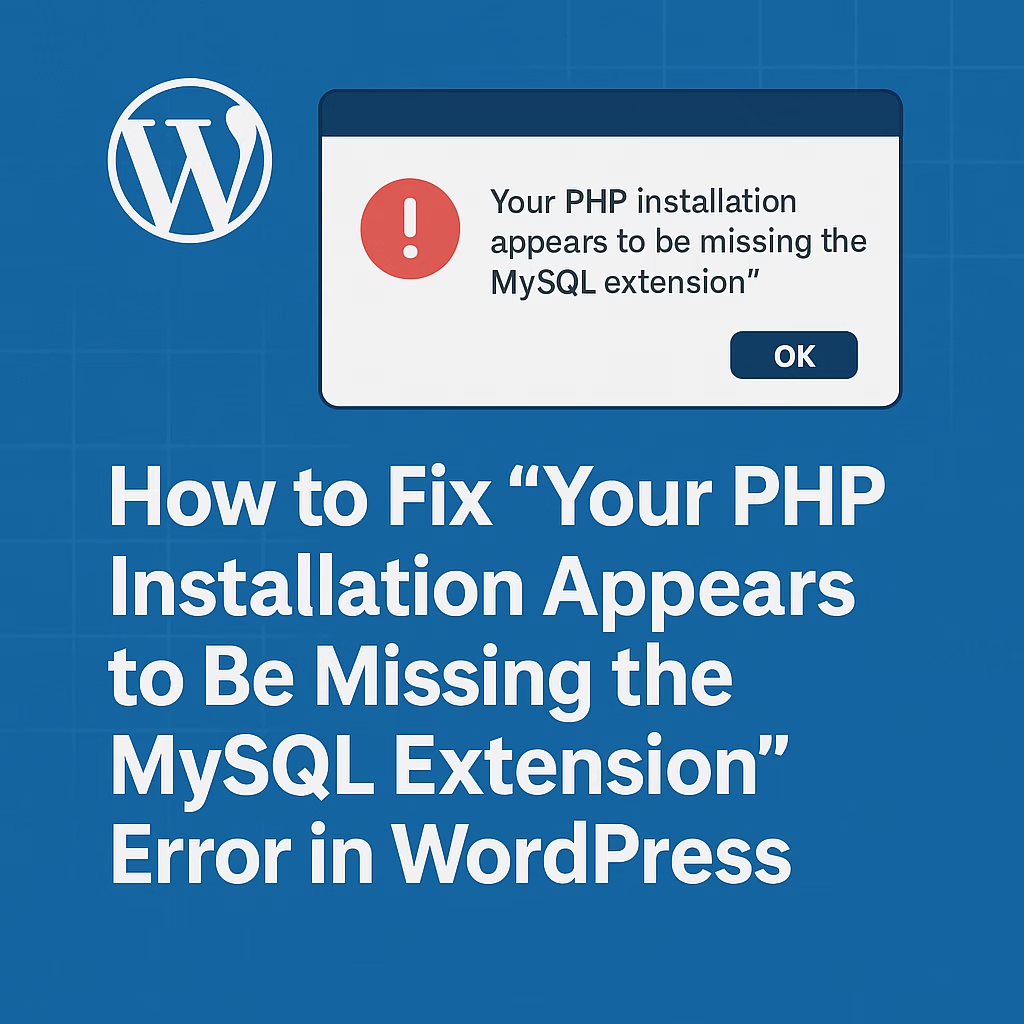This error usually means your WordPress site is running on a server where the PHP MySQL extension is not installed or enabled. WordPress requires this extension to communicate with your database.
When trying to set up or access your WordPress site, you might encounter a frustrating error message:
“Your PHP installation appears to be missing the MySQL extension which is required by WordPress.”
This issue typically arises due to outdated PHP versions, missing MySQL extensions, or incorrect server configurations.
In this guide, we’ll walk you through the exact reasons why this error appears and show you step-by-step how to fix it — whether you’re on shared hosting, a local server like XAMPP or MAMP, or a custom VPS. Let’s get your WordPress site back up and running!
Understanding the “Missing MySQL Extension” Error in WordPress
When you see the message “Your PHP installation appears to be missing the MySQL extension which is required by WordPress,” it can be frustrating—especially if you’re not sure where to start. This error typically appears when WordPress cannot connect to your database due to a missing or outdated PHP MySQL extension. Understanding what this means and why it happens is the first step toward resolving it quickly.
1. What Is the MySQL Extension in PHP?
The MySQL extension is a set of functions that allows PHP to communicate with MySQL databases—essential for WordPress to run. However, this extension is deprecated in newer PHP versions in favor of improved alternatives like MySQLi and PDO_MySQL.
2. Why WordPress Needs a Database Connection
WordPress stores everything—from posts and pages to user data and settings—in a MySQL database. If the required PHP extension is not available, WordPress cannot retrieve or store this data, resulting in a fatal error that halts your site.
3. Why This Error Happens in Modern Setups
In most modern hosting environments, this error happens because:
- You’re running an outdated version of WordPress on a server using PHP 7.0 or later.
- Your server is missing the mysqli or pdo_mysql extension.
- PHP is not properly configured to load these extensions.
Common Causes Behind the MySQL Extension Error
The “Your PHP installation appears to be missing the MySQL extension” error may look technical, but it usually stems from a few common misconfigurations. Understanding the root cause will help you apply the right fix quickly. This issue often relates to outdated software, missing server modules, or incorrect server settings.
1. Outdated WordPress Version
Older versions of WordPress (prior to 3.9) rely on the deprecated mysql extension, which has been removed from PHP 7.0 and later. If you’re running a legacy version of WordPress on a modern server with updated PHP, the system won’t recognize the extension—causing this error.
2. Missing or Disabled MySQLi Extension in PHP
Even if your PHP version is compatible, your server must have the MySQLi or PDO_MySQL extension enabled. Without these, PHP cannot connect to your MySQL database, and WordPress will throw the missing extension error.
3. Misconfigured or Corrupted PHP Installation
In some cases, the PHP installation itself may be incomplete or misconfigured. A missing or improperly set php.ini file could prevent essential extensions from loading, including MySQLi. This can happen during a server migration or manual PHP installation.
Check Your PHP Version and Compatibility
One of the first steps in fixing the “missing MySQL extension” error is to verify that your PHP version is compatible with your WordPress installation. As PHP evolves, certain extensions are deprecated or removed entirely, which can affect how WordPress interacts with your server. Ensuring compatibility between your PHP version, WordPress version, and required extensions is critical to resolving this issue.
1. How to Check Your Current PHP Version
You can easily check your PHP version by uploading a simple phpinfo.php file to your server. Just create a file with the following contents:
<?php phpinfo(); ?>Upload it to your site’s root directory and open it in your browser. The PHP version will be displayed at the top. Alternatively, many hosting dashboards (like cPanel or Plesk) show your PHP version directly in the control panel.
2. Minimum PHP Version Required by WordPress
As of recent WordPress releases, the minimum recommended PHP version is PHP 7.4 or higher. However, older WordPress versions (before 3.9) relied on the outdated mysql extension, which was removed in PHP 7.0+. If you’re running such an old version of WordPress on a newer PHP environment, this incompatibility will trigger the error.
3. Matching PHP Extensions with WordPress Requirements
Modern WordPress installations use either MySQLi or PDO_MySQL. Your server must have at least one of these enabled. You can confirm this by checking your phpinfo() output or contacting your hosting provider. If none of these extensions are available, WordPress won’t be able to communicate with your database, causing the error to appear.
How to Install or Enable the MySQL Extension on Your Server
Once you’ve identified that the MySQL (or MySQLi) extension is missing or disabled, the next step is to install or enable it based on your server environment. Whether you’re using a shared hosting provider, a VPS, or a local server setup, the method will differ slightly. Most modern hosting platforms already support MySQLi, but in some cases, it might need to be manually installed or activated.
1. Enabling MySQLi on a Linux-Based Server (Ubuntu/Debian)
If you’re using a VPS or a local development environment with Linux, you can install the MySQLi extension using the command line. For most Ubuntu or Debian systems, run the following command:
sudo apt-get install php-mysqliAfter installation, restart your web server:
sudo service apache2 restartIf you’re using Nginx, restart PHP-FPM as well:
sudo service php7.x-fpm restart2. Installing MySQLi on Windows (XAMPP/WAMP)
For local development environments like XAMPP or WAMP on Windows, the extension is usually included but may not be enabled by default.
- Open your
php.inifile (located in thephpfolder of your XAMPP/WAMP installation). - Search for the following line:
;extension=mysqli- Remove the semicolon
;to uncomment it, so it looks like:
extension=mysqli- Save the file and restart Apache.
3. Contacting Your Hosting Provider for Support
If you’re on shared hosting and don’t have access to server-level configuration, the best solution is to contact your hosting provider’s support team. Ask them if the MySQLi or PDO_MySQL extension is enabled on your server. Reputable hosts can quickly enable it for you or guide you on switching to a compatible PHP version.
Still Not Working? Final Troubleshooting Steps
If you’ve updated your PHP version, installed or enabled the correct extensions, and the error still won’t go away, there may be other underlying issues causing WordPress to throw the “missing MySQL extension” message. In these cases, a few additional checks and steps can help you pinpoint the problem and finally get your site back online.
1. Check Your php.ini Configuration File
The php.ini file controls which extensions are loaded in your PHP environment. If the MySQLi or PDO_MySQL extensions are installed but not loading, your php.ini file may be missing the appropriate directives.
To check:
- Open
php.iniand search for lines like: iniCopyEdit
extension=mysqli
extension=pdo_mysql- Ensure they are not commented out (no semicolon
;at the beginning). - Save the file and restart your web server (Apache or Nginx).
Also verify that the extension_dir path in php.ini is correctly pointing to your PHP extension directory.
2. Switch to a Supported PHP Version
Sometimes the error occurs because your server is running a very old or very new version of PHP that’s not fully compatible with your WordPress version. If you’re using a control panel like cPanel or Plesk, look for the PHP Version Manager and try switching to a different PHP version (preferably PHP 8.1 or 7.4).
This ensures that you’re using a version with proper extension support and compatibility with the latest WordPress release.
3. Reinstall or Update WordPress
If everything on the server side looks correct but the error persists, your WordPress core files may be outdated or corrupted. To resolve this:
- Download the latest version of WordPress from wordpress.org.
- Replace the
wp-adminandwp-includesfolders on your server with the fresh copies. - Do not touch the
wp-contentfolder to avoid losing your themes and plugins.
This can fix any mismatches between your PHP environment and old WordPress files that still rely on deprecated functions.
Final Thoughts
The “Your PHP installation appears to be missing the MySQL extension” error can seem daunting at first, but it’s usually caused by a mismatch between your WordPress version, PHP version, and server configuration. By understanding the root causes and following the proper troubleshooting steps—checking your PHP version, enabling the right extensions, and ensuring compatibility—you can resolve the issue quickly and get your WordPress site back up and running.
If you’re still stuck after trying all the solutions, don’t hesitate to reach out to your hosting provider or a developer for assistance. Keeping your WordPress environment up to date with modern PHP versions and server configurations not only prevents errors like this but also improves performance and security across your entire site.
Need help rebuilding your layout? Contact me and I’ll help you get your site back on track.




